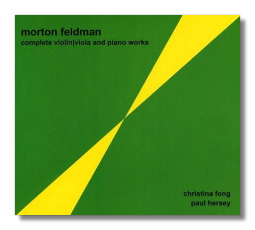
The Internet's Premier Classical Music Source
Related Links
- Feldman Reviews
- Latest Reviews
- More Reviews
-
By Composer
-
Collections
DVD & Blu-ray
Books
Concert Reviews
Articles/Interviews
Software
Audio
Search Amazon
Recommended Links
Site News
 CD Review
CD Review
Morton Feldman

Complete Works for Violin/Viola and Piano
- [Sonata] for Violin & Piano
- Piece
- Projection 4
- Extensions 1
- Vertical Thoughts 2
- The Viola in My Life 3
- Spring of Chosroes
- For Aaron Copland
- For John Cage
- [Composition] for Violin
Christina Fong, violin/viola
Paul Hersey, piano
OgreOgress DDD 2CDs: 58:36, 70:32
This 2-CD set includes all of Morton Feldman's works for violin or viola and piano, including world première recordings of the Sonata, a student-work written in 1945 when the composer was 19, and the ten-minute [Composition] – apparently it is officially nameless! – from 1984. From one to the other, with everything in between, Fong and Hersey present us with a pretty good retrospective of the composer's career, albeit from a necessarily limited point of view.
There are three masterworks here: The Viola in My Life 3 (1970, 4 minutes), Spring of Chosroes (1977, 13 minutes), and For John Cage (1982, 65 minutes).The Viola in My Life was written for Karen Phillips. This series of four works – the first two are chamber works, and the fourth is a concerto – find Feldman zeroing on the timbre of a particular instrument as he had seldom done before, and would consistently do in the future. Because of its brevity, The Viola in My Life 3 is a good introduction to Feldman for those who are not quite sure that he is for them.
The title Spring of Chosroes is an allusion to a Persian king who lived during the 6th century, and his famous "Spring Carpet," which was woven of silk, wool, gold, and silver, and studded with precious stones. The violinist quickly alternates between playing with the bow and pizzicato, and both she and the pianist content themselves with a limited number of notes. At first exposure, Spring of Chosroes seems arcane, but over time, one comes to appreciate how much is done with so little. Again, timbre becomes an equal with pitch, rhythm, and harmony.
For John Cage is typical of Feldman's later work in the way in which an extended time span is absolutely essential for realizing the composer's ideas. Slowly and methodically, the two musicians explore one pattern after another, turning it one way and another before surrendering themselves to the next one. Perhaps that description sounds clinical, but in truth, this is music of infinite tenderness… a cherishing of all that moves on, fades away, and decays.
Fong and Hersey are not the first performers to record Feldman's "complete" music for violin and piano. Violinist Marc Sabat and pianist Stephen Clarke did so for Mode (Mode 82/83), but they omitted the Sonata, the two solo violin works ([Composition] and For Aaron Copland), and The Viola in My Life 3. (Apparently the Paul Sacher Foundation made some of these available for the present recording.) Also, Sabat and Clarke spend nearly 82 minutes with For John Cage – a welcome protraction, but one which necessitates spreading the work across two CDs. Hearing it unbroken, as it is presented here by Fong and Hersey, is of tremendous value. These two musicians play with tremendous concentration, and with deep attention to timbral values. The trick in For John Cage is for the pianist to make his instrument sound like a violin as much as possible. Hersey does an excellent job of that here.
The other works are of variable intrinsic interest, but taken as a group, they trace Feldman's evolution from a talented imitator of Bartók to an inimitable original. It is a pleasure to go on this journey with Fong and Hersey. There are brief booklet notes by Ingvar Loco Nordin and the late John Story. Ideally, music should speak for itself, but Mode's annotations have more to offer than those presented here. The sound is intimate and – even at the low volumes which Feldman's music demands – rich and impactful.
Copyright © 2006, Raymond Tuttle




















